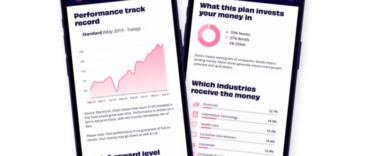
If you currently have a pension either through your employer or one held personally you can transfer this pension to another provider if you wish.
However, transferring a pension is a complicated process and a decision that should not be taken lightly. In this article, I explain everything you need to know when considering a pension transfer along with how to transfer a pension should you deem it appropriate.
Things to know when considering transferring a pension
Transfer a final salary pension (defined benefit scheme)
In most cases you will be better off with a final salary (defined benefit) pension scheme rather than transferring it to a Self Invested Personal Pension (SIPP) or other personal pension product. This is also the view of the FCA, the financial regulator. A final salary (defined benefit) pension is an occupational pension scheme run by an employer where the level of pension income a person receives is dependent on their salary at retirement. As well as providing the employee with a pension, these schemes will normally provide benefits for the spouse or partner of the employee and dependents. These schemes are often index-linked providing an inflation-protected income in retirement.
Interestingly, not everyone who has a final salary pension can transfer it. For example those with a final salary pension in payment or those who are members of an unfunded public sector final salary scheme are prohibited from transferring out.
If you are considering transferring from a final salary scheme you will need to acquire a cash equivalent transfer value (CETV) from your employer. You can request this from the scheme itself or alternatively it is sometimes included on your annual pension statement. The size of the CETV is critical when determining whether you should transfer your final salary pension. The CETV is the cash value that your final salary pension benefits are worth, as a lump sum, which you can transfer into a pension (typically a SIPP) to either invest or withdraw (cash-in).
Due to the size of the future pension promises some employers are struggling to adequately fund their final salary pension schemes. As a result, a number of pension schemes are offering very generous cash equivalent transfer values (CETV) to encourage people to transfer out. The difficulty comes in determining whether the CETV represents good value or not. Historically this has meant engaging the services of a financial adviser, and being charged by them, even before they give you any formal pension transfer advice. You can read more about transferring a final salary pension in our article 'Should I transfer my final salary pension?'
Free pension transfer calculator
Fortunately, there is now a free pension transfer calculator which calculates whether your CETV represents good value. You don't even need to have your CETV to hand as the pension transfer calculator can estimate a value based upon the annual pension income you should receive. Once you have used the pension transfer calculator you will also be emailed the results.
Transfer a defined contribution pension (such as a personal pension)
If you are considering transferring from a defined contribution scheme then you will need to get a formal pension transfer value from the pension provider or scheme administrator. Alternatively, you can find a transfer value on your annual statement. A defined contribution scheme is one where the final pension is determined by the level of income that your pension pot can generate. This pension pot is dependent upon the amount of contributions you've paid into your pension and the associated investment growth over time.
When you decide to retire, which must be after age 55, you then use this pension pot to produce an income for yourself. This can be via an annuity, drawdown or by simply cashing in your pension. Defined contribution pension schemes typically don't offer guarantees and the pension transfer analysis is far easier and less onerous as a result. However, make sure that you check whether your pension has any guarantees, such as guaranteed annuity rates, before doing anything.
Most company schemes will allow a pension transfer to a self-invested personal pension (SIPP), personal pension, stakeholder pension or a company scheme. It is advisable to speak to a reputable independent financial adviser and importantly, make sure that they are also a pension transfer specialist. Research by the Financial Conduct Authority (FCA) in 2018 suggests that independent financial advisers were responsible for delivering poor pension advice, driven by the conflict of interest in the way they are remunerated. They found that 69% of consumers are advised to transfer their defined benefit pension scheme, despite its view that most would be better off sticking with their existing scheme. As a result, the FCA introduced a ban on contingent charging, something that came into force on 1st October 2020. You can read more in our article 'What is contingent charging and what does it mean for me?'
Can you transfer a final salary pension without using a financial adviser?
If you are considering transferring a final salary pension into a self-invested personal pension (SIPP), personal pension or stakeholder pension it really is advisable to speak to an independent financial adviser who specialises in pension transfers. If the cash equivalent transfer value of your pension is worth more than £30,000 then you have to have a regulated financial adviser enact the pension transfer. However, reputable financial advisers will still need to carry out a transfer analysis even if you insist that you wish to make the transfer regardless (known as an execution-only pension transfer).
When might you consider transferring your pension?
There are a number of situations where you might consider transferring your pension, such as:
- you have a number of pension contracts that you want to consolidate into one pension to make it easier to administer
- you have an existing personal pension which has a limited investment choice
- you want to reduce the costs involved in maintaining your current pension plans
- your current pension scheme is closing
- you are moving abroad and want to transfer to a scheme in another country
- you are looking for a more flexible pension option
Transfer Incentives
Pensions schemes provided by your employer are expensive to administer and final salary schemes can leave employers with a very expensive long term financial commitment. As briefly mentioned above, this has resulted in a number of employers offering incentives (and generous transfer values) for members to either transfer their pensions away from the company or accept changes to their pension benefits.
These incentives could be:
- an increased transfer value to move your pension provider (i.e a higher CETV)
- a reduced pension in exchange for other benefits such as life cover or a dependent pension
- an increased initial pension in exchange for removal of index linking
Employers are expected to follow a code of conduct when offering incentives to employees so that they don't feel pressurised into making a decision. A key element of this code is providing the employee with access to independent financial advice paid for by the employer.
When should you not consider transferring your pension?
There are a number of instances when you should not consider transferring your pension, these include:
- if you will lose any benefits such as index linking, life cover or a dependants' pension
- if your current pension scheme provides a guaranteed annuity option which may be higher than annuity rates available on the open market
- where your current pension scheme applies a significant charge to transfer
- if the investment options available in the new scheme are limited or risky and you will require ongoing financial advice which could be costly
- you are close to retirement and changing to a different pension provider may be detrimental in the short term
How do pension transfers work?
The pension transfer application starts when you request a transfer value from your current pension provider.
If you are transferring from a final salary (defined benefit) scheme then this pension transfer will be expressed as a cash equivalent transfer value (CETV) where your current accrued benefits are expressed as a cash sum. This CETV will be guaranteed for 3 months and the expiry date should be shown on the transfer document.
The CETV is an estimate of the money required to be invested now to provide your 'preserved pension' which is your current pension entitlement under your current scheme. Once you have decided to proceed with the transfer your pension administrator must complete the transfer within 6 months.
If you are transferring from a defined contribution scheme you need to request a pension transfer value from your current pension scheme administrator. Typically a defined contribution pension is invested in stocks and shares so any pension transfer value provided is only a snapshot of the current pension transfer value. The actual amount of pension transfer will depend on the pension value at the point at which the funds are actually transferred, this may be lower or higher than the original pension transfer value quoted.
Pension transfer rules and fees
The pension transfer process is quite complicated and governed by a strict set of rules to protect the individual. Given its complexity, you should always seek independent financial advice from a pension transfer specialist who can give advice on moving pensions.
You may be charged fees to transfer your pension and this could, with larger pension pots, run into thousands of pounds. Always check the amount of fees charged for your pension transfer and ensure that these are not eroding the benefits of transferring.
Pension transfer value calculation
If you are transferring from an existing personal pension to another personal pension or a SIPP or a SIPP to another SIPP (i.e. defined contribution pension to defined contribution pension) then the pension transfer value will be the current value of the fund(s) that make up your current pension. This transfer value is not guaranteed and may differ significantly (either up or down) when the final transfer goes through.
As mentioned earlier, if you are transferring from an occupational pension to a personal pension or SIPP then a cash equivalent transfer value (CETV) will be provided. The CETV is the value of investment needed to provide the level of pension you have currently accrued within your current company scheme and is guaranteed for 3 months.
Types of pension transfers
Transferring a pension to a SIPP
A Self Invested Personal Pension is an attractive option for transferring a pension. It is possible to transfer a personal pension to a SIPP, a work pension to a SIPP or transfer a SIPP to a SIPP from another provider.
A SIPP offers a flexible pension option with a wide selection of investment choices and can be managed online with the current value of your pension always available to view. Managing a SIPP portfolio is simple and is an ideal choice for someone who wants to have more control over their investment decisions. From time to time, SIPP providers will run cashback offers which can make pension transfers particularly attractive and Interactive Investor* is currently running such an offer. You can read our analysis of the best and cheapest SIPPs. If you already have a SIPP and are considering transferring, check out our article 'Should I transfer my SIPP?'.
Occupational pension transfers
It is possible to transfer an occupational pension, or work pension, to a personal pension, SIPP or a new employer's occupational pension if that scheme allows transfers.
It is possible, however, that if you transfer a company pension to a personal pension or a SIPP that some benefits of your old scheme may be lost. Benefits such as life cover and spouse/partner or dependent benefits can be invaluable and should not be dismissed lightly.
Transferring multiple pensions into one
If you have multiple defined pensions from previous employers you may have lost details of them. There are a number of ways in which you could find lost pensions. The first way (which is free) is to use the pension tracing service. However, you will need to know the name of any previous employers or pension schemes. The tool will then provide you with contact details for the scheme administrators who you will need to contact yourself. The tool will not tell you if you have a pension or how much it is worth.
The alternative is to use services such as PensionBee* or Profile Pensions. They will locate any lost pensions for you and also consolidate them into a low-cost pension.
Pension transfer advice
If you are at all unsure is advisable that you take advice from a pension transfer specialist due to the potential issues that may arise during the pension transfer process. Most good independent financial advisers will have a pension transfer specialist (with the appropriate pension transfer qualification - AF3 or G60) working for the company or will be able to refer to somebody can provide professional advice on the pension transfer process.
If a link has an * beside it this means that it is an affiliated link. If you go via the link, Money to the Masses may receive a small fee which helps keep Money to the Masses free to use. The following link can be used if you do not wish to help Money to the Masses or take advantage of any exclusive offers - Pensionbee, Interactive Investor




